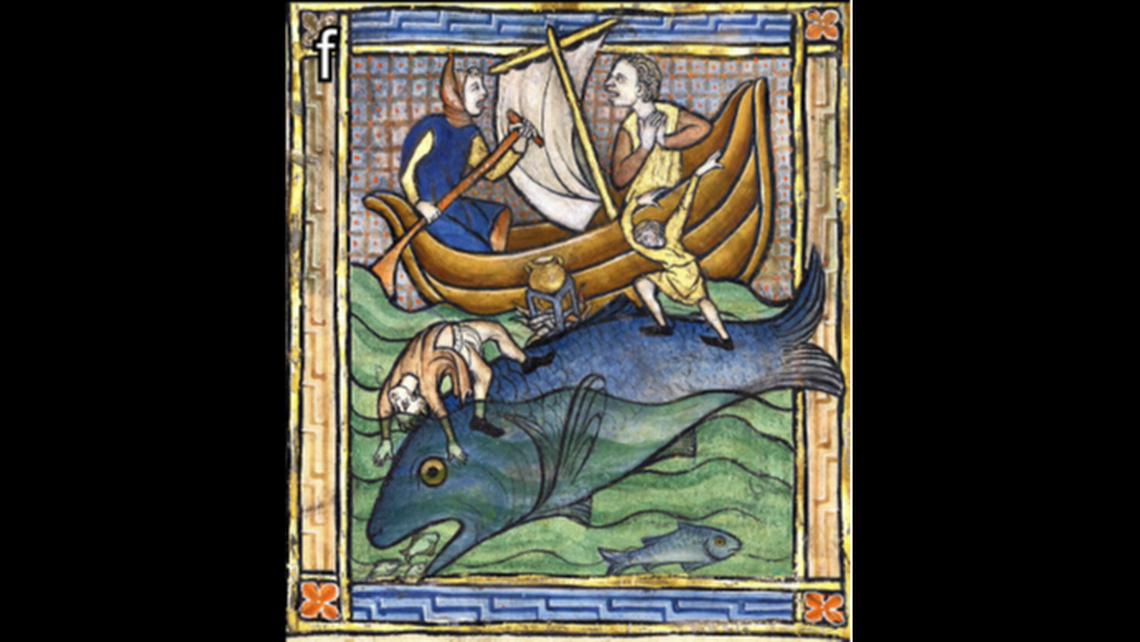Strange behavior of whales may be source of medieval sea monster legend, report says
The origin of a medieval sea monster legend may have been found in a “mysterious” new feeding behavior used by whales, according to a report from Australian researchers.
“Trap feeding,” as it’s called, involves whales hiding in a vertical position while using their open jaws to create a shallow pool on the surface.
But the peaceful oasis is actually a trap.
“Fish think they have found a place to shelter from predators, not realizing they are swimming into danger,” the researchers observed for the study published Feb. 28 in the journal Marine Mammal Science.
Once their mouths are full, the whales close their jaws, trapping large numbers of fish and sea creatures in a terrifying maelstrom of darkness.
It was John McCarthy, a maritime archaeologist at Australia’s Flinders University, who realized the scenario is similar to depictions of Norse sea monsters from historical literature. That giant creature, called the hafgufa, was rumored to lurk below the frigid Icelandic waters.
“The Norse description of the hafgufa was very similar to the behavior shown in videos of trap feeding whales,” McCarthy said in a news release.
“Once I started looking into it in detail and discussing it with colleagues who specialize in medieval literature, we realized that the oldest versions of these myths do not describe sea monsters at all, but are explicit in describing a type of whale.”

Myths of the hafgufa appear in 13th century manuscripts and continue into the 18th century “alongside the more infamous kraken and mermaids,” the study reports.
The hafgufa “looked more like an island than a fish,” gave off a strong odor and would belch bits of fish, according to a manuscript attributed to Norwegian King Hakon Hakonarson, who reigned from 1217 to 1263, the study says.
“I am rather reluctant to tell of it because of its great size, which most people will find unbelievable. Few people can say anything clear about it, for it is seldom near land or in the sights of fishermen,” his manuscript reports.
“When it goes to feed, it gives a great belch out of its throat, along with which comes a great deal of food. All sorts of nearby fish gather, both large and small, seeking there to acquire food. ... The big fish keeps its mouth open for a time, no more or less wide than a large sound or fjord, and unknowing and unheeding, the fish rush in in their numbers. And when its belly and mouth are full, (the hafgufa) closes its mouth.”
The attributes of the hafgufa are similar to legends of the “aspidochelone” found in medieval bestiaries, the report notes.
Study co-author Erin Sebo, an associate professor of medieval literature and language at Flinders University, said the legends are an “example of accurate knowledge about the natural environment ... that predate modern science.”
“We found that the more fantastical accounts of this sea monster were relatively recent, dating to the 17th and 18th centuries and there has been a lot of speculation amongst scientists about whether these accounts might have been provoked by natural phenomena, such as optical illusions or under water volcanoes,” Sebo said in the news release.
“In fact, the behavior described in medieval texts, which seemed so unlikely, is simply whale behavior that we had not observed but medieval and ancient people had.”
Researchers credit Instagram for helping them discover “trap feeding” after a video posted in 2011 showed whale using the technique in the Gulf of Thailand.
“It’s not known why this strategy has only recently been identified, but scientists speculate that it’s a result of changing environmental conditions — or that whales are being more closely monitored than ever before by drones and other modern technologies.” the researchers said.
Hikers thought they saw garbage along Alaska coast. It was a field of large bones
Search underway for key WWII battlefield hidden on Pacific seafloor off Guam, team says
Take a ride on the back of a majestic whale in ‘rare and remarkable’ migration video
